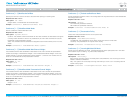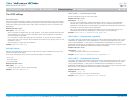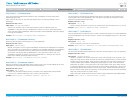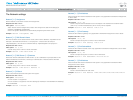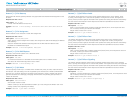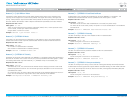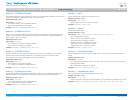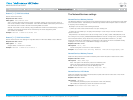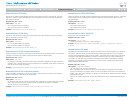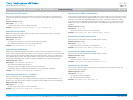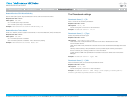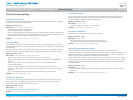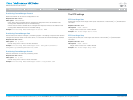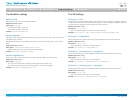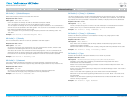
D14850.02 MX Series Administrator Guide (TC5.0) | 2011 NOVEMBER | © 2011 Cisco Systems, Inc. All rights reserved. www.cisco.com
46
Cisco TelePresence MX Series
ADMINISTRATOR GUIDE
Set the HTTP mode to enable/disable access to the system through a web browser. The web
interface is used for system management, call management such as call transfer, diagnostics
and software uploads.
ADMIN
<On/Off>
On: The HTTP protocol is enabled.
Off: The HTTP protocol is disabled.
NetworkServices HTTP Mode: On
HTTPS is a web protocol that encrypts and decrypts user page requests as well as the pages
that are returned by the web server.
ADMIN
<On/Off>
On: The HTTPS protocol is enabled.
Off: The HTTPS protocol is disabled.
NetworkServices HTTPS Mode: On
When the system connects to an external HTTPS server (like a phonebook server or an external
manager), this server will present a certificate to the system to identify itself.
ADMIN
<On/Off>
On: Requires the system to verify that the server certificate is signed by a trusted Certificate
Authority (CA). This requires that a list of trusted CAs are uploaded to the system in advance.
Off: Do not verify server certificates.
NetworkServices HTTPS VerifyServerCertificate: Off
When the system connects to a HTTPS client (like a web browser), the client can be asked to
present a certificate to the system to identify itself.
ADMIN
<On/Off>
On: Requires the client to present a certificate that is signed by a trusted Certificate Authority
(CA). This requires that a list of trusted CAs are uploaded to the system in advance.
Off: Do not verify client certificates.
NetworkServices HTTPS VerifyClientCertificate: Off
Define the support for OCSP (Online Certificate Status Protocol) responder services. The OCSP
feature allows users to enable OCSP instead of certificate revocation lists (CRLs) to check
certificate status.
ADMIN
<On/Off>
On: Enable OCSP support.
Off: Disable OCSP support.
NetworkServices HTTPS OCSP Mode: Off
Specify the URL of an OCSP server.
ADMIN
<S: 0, 255>
Format: String with a maximum of 255 characters.
NetworkServices HTTPS OCSP URL: "http://ocspserver.company.
com:81"
The Network Time Protocol (NTP) is used to synchronize the time of the system to a reference
time server. The time server will subsequently be queried every 24th hour for time updates.
The time will be displayed on the top of the screen. The system will use the time to timestamp
messages transmitted to Gatekeepers or Border Controllers requiring H.235 authentication.
The system will use the time to timestamp messages transmitted to Gatekeepers or Border
Controllers that requires H.235 authentication. It is also used for timestamping Placed Calls,
Missed Calls and Received Calls.
ADMIN
<Off/Auto/Manual>
Off: The system will not use an NTP server.
Auto: The system will use the NTP server, by which address is supplied from the DHCP
server in the network. If no DHCP server is used, or the DHCP server does not provide the
system with a NTP server address, the system will use the static defined NTP server address
specified by the user.
Manual: The system will always use the static defined NTP server address specified by the
user.
NetworkServices NTP Mode: Manual
Introduction
Table of contents
Web interface
Advanced settings
Appendices
Advanced settings



